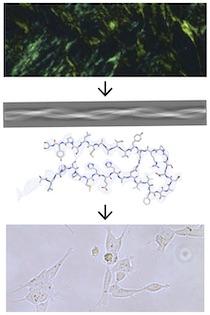
Top Image: Stained amyloid deposits in cardiac tissue from a person with ATTR.
Middle Image: 2D class averaging of amyloid fibrils obtained from cryo-electron microscopy and reconstructed structural model.
Bottom Image: HepG2 cells expressing human transthyretin.
Our Interests
The Saelices Laboratory studies neurological and systemic disorders caused by amyloid deposition. We seek to understand the molecular basis and the biology of amyloid formation and its precursors, and to develop clinical tools for early detection and inhibition of amyloids.
Amyloids are prion-like deposits that form when a protein partly unravels and sticks to other misshapen copies of itself. They not only occur in numerous neurodegenerative disorders, but also arise in cardiac tissue; an estimated three million people in the U.S. have cardiac amyloidosis.
Amyloid deposits in the heart reduce its health, and trigger formation of additional deposits, in a templating process called seeding. Thus, amyloid formation leads to more amyloid formation, causing further heart dysfunction and eventual heart failure.
There are no currently approved drugs in the US that target amyloid seeding.
Our lab focuses on seeding in the cardiac disease transthyretin amyloidosis (ATTR), caused by the systemic deposition of the blood protein transthyretin. In ATTR, cardiac deposition happens spontaneously, although genetic mutations can increase risk.
Our lab extracts ATTR amyloid deposits, analyzes the molecular structure, and uses cell culture to evaluate probes designed from the structural information.
Our Tools
Our laboratory employs crystallography and cryo-electron microscopy to study the molecular basis of amyloid deposition. We then use rational and computational design to generate probes that bind these structures and that can be used as inhibitory agents or as detection tools.
For instance, we have created a peptide that blocks amyloid seeding of transthyretin in the test tube and in flies with amyloid disease.
We also use cell culture to understand the biological role of amyloid deposits and their precursors, and to test our structure-based design of specific probes.
Join Our Lab
We seek graduate students, postdocs, and technicians to join our exciting work.